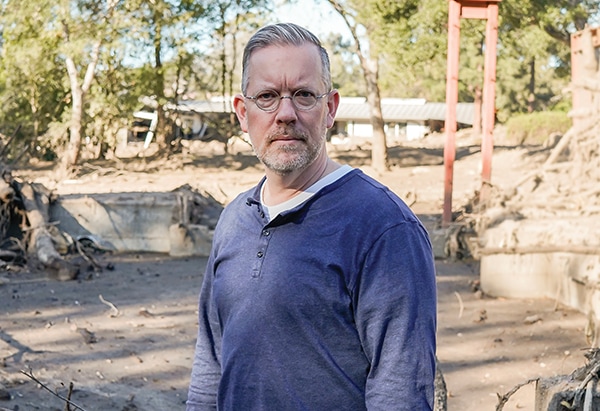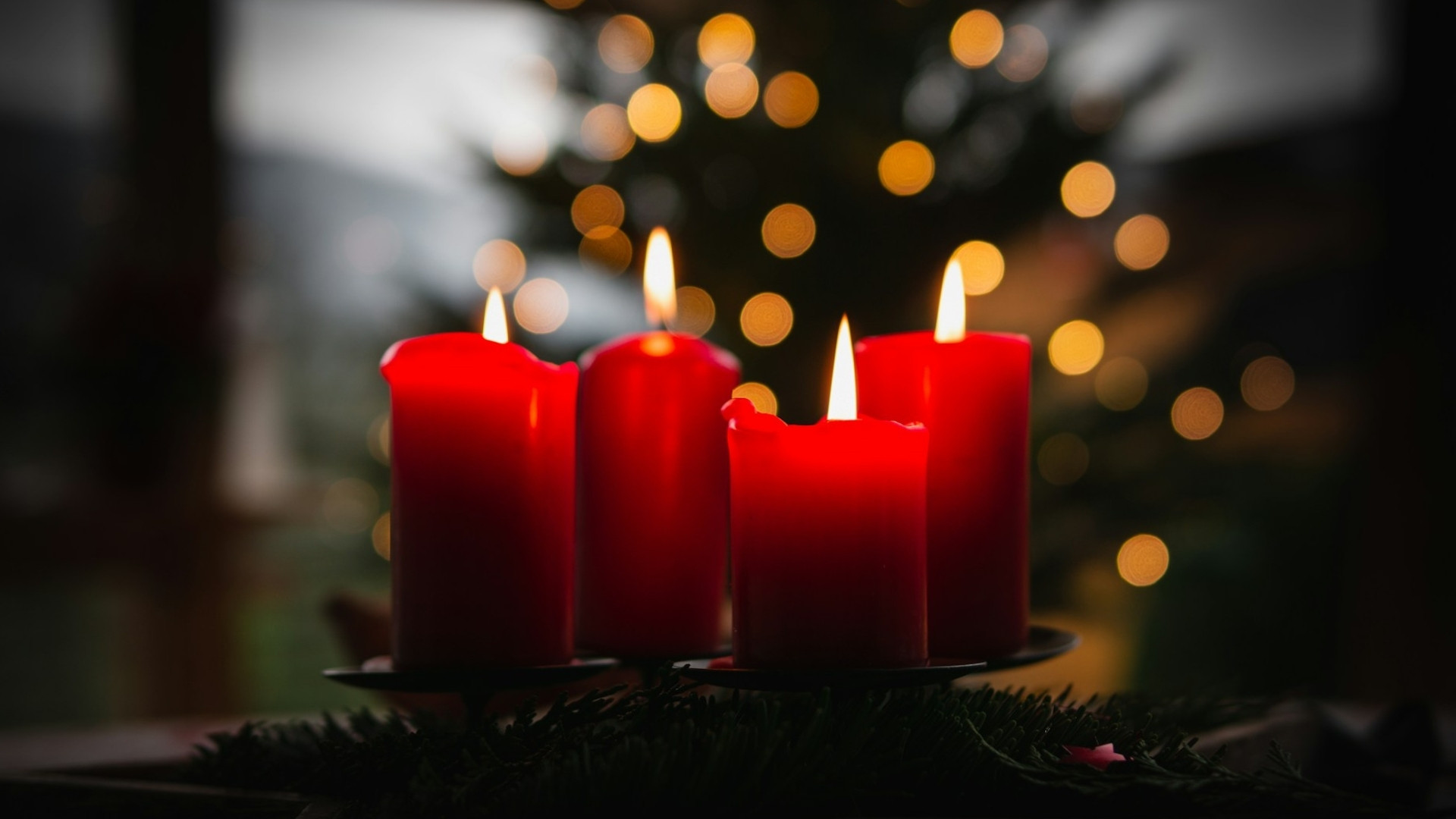[vc_row][vc_column][vc_column_text]
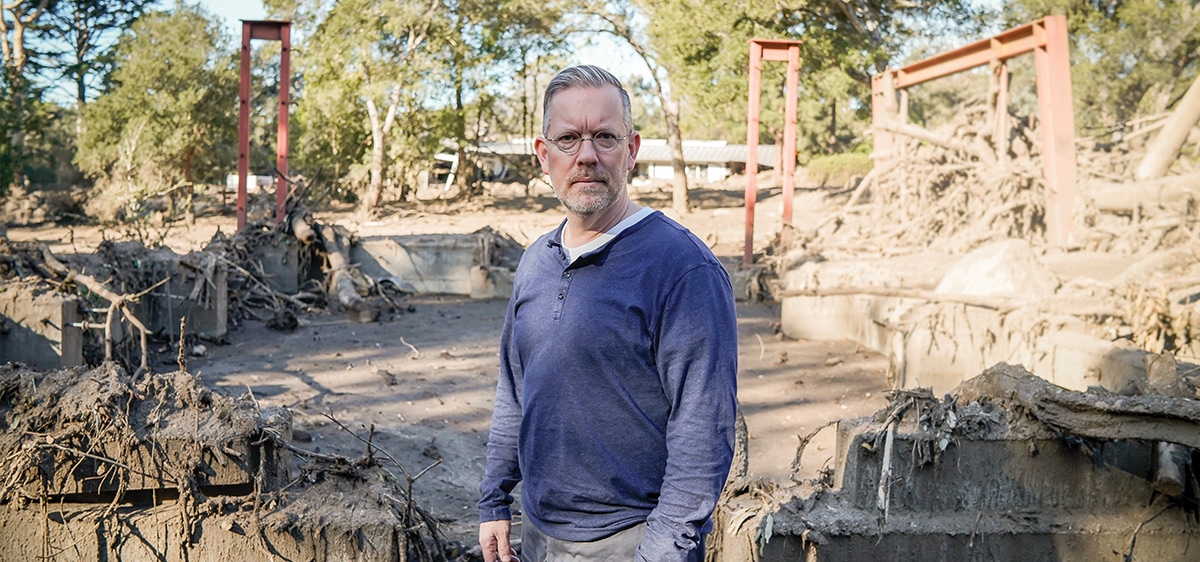
[/vc_column_text][/vc_column][/vc_row][vc_row el_class=”hero-header-text”][vc_column][vc_column_text]
Catastrophic grace
How Covenanters are extending God‘s love In the aftermath of unimaginable destruction and loss.
by Stan Friedman | March 6, 2018
[/vc_column_text][/vc_column][/vc_row][vc_row][vc_column][vc_column_text]
Pictured above: Jon Lemmond, associate pastor of Montecito Covenant Church
[/vc_column_text][vc_column_text]This story is Part one of the Disaster Relief series. Click here to view additional stories.[/vc_column_text][/vc_column][/vc_row][vc_row][vc_column][vc_separator][vc_column_text]
Hurricane Harvey: Houston
[/vc_column_text][/vc_column][/vc_row][vc_row][vc_column][vc_column_text]
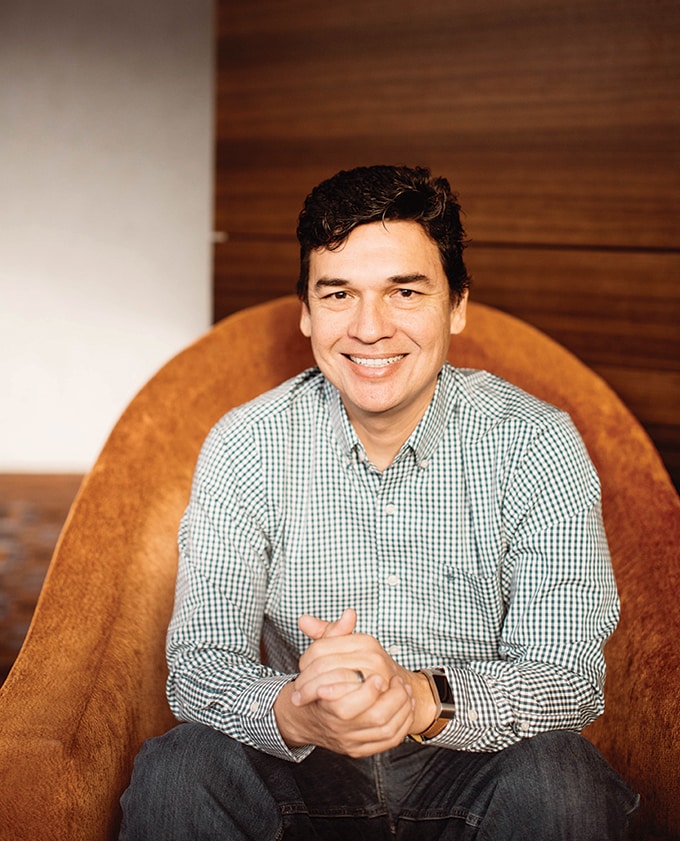
It was the middle of August, the end of a busy season for Mario Valdes, who leads mission trips with Merge Ministries of Serve Globally. He was looking forward to some rest. And then Hurricane Harvey parked over Texas for four days and dropped more rainfall than any storm since records started being kept in the 1880s. Valdes realized his plans for a quiet September were gone. Valdes lives in Mexico’s Yucatan Peninsula, but since the storm, he has spent up to a month at a time in Houston, helping work crews
of Covenanters and others from across the country as they first mucked out houses and then helped with reconstruction.
Valdes pauses to gather his words as he tells of a woman who stood in shock surveying the downed trees, damaged buildings, on her street. “She looked at one house, and then the next house, and the next house. It was like that all across her neighborhood.” Trying to grasp the enormity of what had happened overwhelmed her. “Just thinking about her right now, I want to start crying,” he says.
Similar scenes would be replayed over and over in the following months as a number of major disasters left wide swaths of devastation in the U.S., Caribbean, and Mexico from August through January. Hurricanes, fires, floods, earthquakes, and mudslides killed hundreds of people, destroyed thousands of homes, and caused hundreds of billions of dollars in total economic impact. Months later, many people remain displaced, and a half million people in Puerto Rico still have no electricity.
Covenanters have donated more than two million dollars through Love Mercy Do Justice (LMDJ), conferences, and churches for immediate assistance and long-term recovery. Churches in these areas have ministered to their communities amid extensive losses suffered by their own members.
Valdes says for people who have been in disasters, hope often comes in small slices, little by little, day by day. Newlyweds Stephanie and Earvin Yen, members of Access Covenant Church in Houston, were among the people whose homes sustained significant damage. Because their neighborhood had never flooded and was well outside a flood zone, they had no insurance. “It was humbling to have people come down to help us,” Stephanie said. “There were fifteen people at our house helping with remediation at one point. They all just had servants’ hearts. It was a huge weight off of our shoulders.”
I’m still in love with the ministry—helping people, sharing hope, and telling someone else that someone cares for you.
Covenanters working through Merge are helping those with Covenant connections and those who have never heard of the church. “We don’t care whether they are believers,” says Valdes. Or what neighborhood they come from—the church is helping people in middle-class areas as well as in some of the poorest. “You know everyone has a need in a different area,” Valdes says. “Some middle-class residents who didn’t have insurance have lost several hundred thousand dollars. It gets back to everyone suffers trauma.” That trauma, as well as the physical needs, will take a long time to heal and repair.
Although Valdes is employed by Merge, it is LMDJ that is coordinating the dispersal of funding and overseeing partnerships with local organizations. But the work in Houston and other disaster areas has just begun. “We will be helping these areas recover for years to come,” says Cecilia Williams, executive minister of LMDJ.
As for Valdes, he says, “Fourteen years have passed since I started working with Merge and I’m still in love with the ministry—helping people, sharing hope, and telling someone else that someone cares for you.”
[/vc_column_text][/vc_column][/vc_row][vc_row][vc_column][vc_separator][vc_column_text]
Hurricane Irma: Orlando
[/vc_column_text][/vc_column][/vc_row][vc_row][vc_column][vc_column_text]

[/vc_column_text][vc_column_text]Sarah Robinson, pastor of Audubon Park Covenant Church in Orlando, Florida, says Hurricane Irma gave the congregation a new sense of purpose and ministry direction. It also almost forced the church to close for good.
The church had been struggling financially, and Robinson’s salary had been cut to half-time prior to the storm. Yet, despite the challenges, the congregation was committed to serve, and had been looking for ways to reach out to their neighborhood. They found their opportunity in the midst and aftermath of the hurricane.
When Irma hit their area Sunday, September 10, most congregations cancelled their services, but Audubon Park stayed open. “We had the same number of people we normally have, and we also did our first Facebook live broadcast,” Robinson says.
People kept saying, ‘We’re talking together. We don’t do this enough.
The 400-mile-wide storm intensified that night, knocking out power to four million customers. The church was one of the few buildings in its neighborhood to retain power. “As soon as the curfew was over on Monday night, we were able to open our doors,” Robinson says. “A handful of us slept at the church for the first few nights. We offered movies. If anyone needed to sit in some air conditioning or use a computer, they could come to the church. People were cooking their meals and taking them back home and sharing them with others. They were eating together at the church. It was wonderful. People kept saying, ‘We’re talking together. We don’t do this enough.’”
Hurricane preparations made more than a decade ago helped the church minister to its neighborhood through the latest storm. Audubon Park was able to distribute coolers, gloves, protective gear, lights, first-aid kits, and collapsible water jugs that had been stored at the church. As parents returned to work, the church put on day camps for kids while schools remained closed for a week.
While the congregation was committed to serving its community, it also had to face the very real threat that it might not be able to continue ministry. Irma had significantly damaged the church’s roof, and they could not afford the $6,500 to pay for a new one. Thankfully, LMDJ provided the funds.
“That was the difference between vital ministry and closing,” Robinson says.
The congregation is making plans to continue to be a gathering place. “All of this has helped form our future ministry outlook in some really beautiful and exciting ways because of the storm,” Robinson says.[/vc_column_text][/vc_column][/vc_row][vc_row][vc_column][vc_separator][vc_column_text]
Hurricane Maria: Puerto Rico
[/vc_column_text][/vc_column][/vc_row][vc_row][vc_column][vc_column_text]
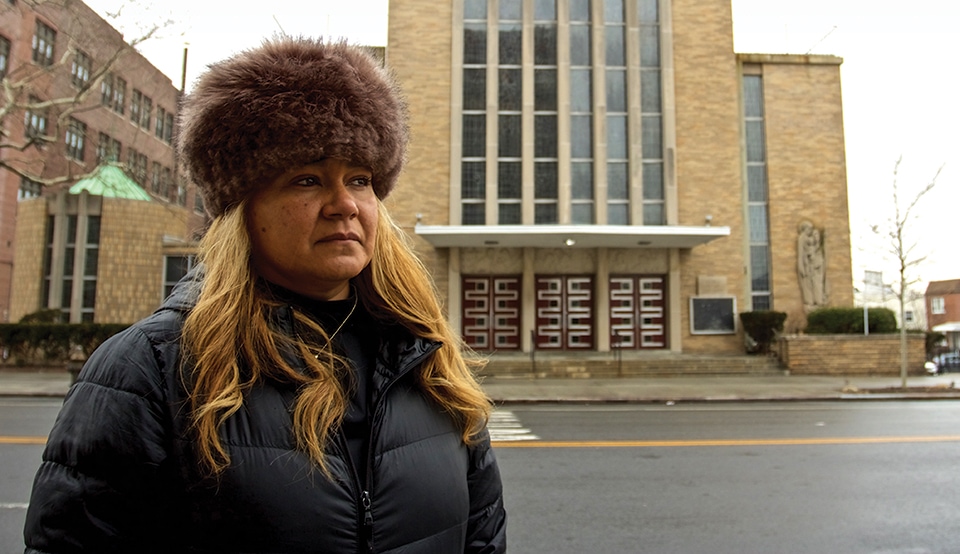
Jesus (Jay) La Luz, an evacuee from Puerto Rico, is thrilled to be working at an Applebee’s restaurant in New York. It’s giving him hope for the future. He and his wife and three young children are among the more than 200,000 Puerto Ricans who have arrived in the continental U.S. since September when Hurricane Maria brought devastation to much of the island.
The La Luz family had intended to stay on the island, despite the extensive damage to their house, but days after the storm looters entered their home and shot Jay. Doctors were able to remove two bullets, but a third remains lodged in a bone. Jay and his wife decided they needed to leave.
Promised Land Covenant Church in Bronx, New York, helped pay for the family’s trip and have provided financial, emotional, and spiritual support, says Iris La Luz, Jay’s aunt and a member of the congregation.
Since shortly after the storm, LMDJ has worked with Promised Land and the National Latino Evangelical Coalition (NaLEC) to provide tons of food and other supplies to thousands of people on the island. They also continue to provide assistance to the Puerto Ricans arriving on the mainland. Promised Land has assisted more than twenty-five families, says pastor Michael Carrion.
You need a mooring, and God has to be the mooring. There’s nothing else.
Church members help the newcomers navigate a system of appointments and applications that can be confusing and overwhelming. “There are so many appointments where if you don’t go there at exactly the right time, they find you ineligible,” says Iris. “That’s the biggest web they have to deal with. You have to go for medical, you have to see if you qualify for food stamps, or qualify for housing, and then you have to bring this ID and go to that office. People go to crisis centers and are asked for identification, but they don’t have it because they lost it in the water or their homes!”
It can be frustrating for those who have been uprooted. “Let us work, let us go make money,” says Jay, echoing others. “I don’t want to get caught up in the system and be poor. I don’t want all these services and going nowhere.”
Promised Land and NaLEC are making sure that children are registered for school and families have access to services, including legal assistance, and are helping them prepare for job opportunities. Just as important, says Iris, the congregation has been helping them get involved in church. “You need a mooring, and God has to be the mooring. There’s nothing else,” she says. “The biggest thing for people is having faith, and knowing that this is going to pass, and it won’t be like this forever.”
[/vc_column_text][/vc_column][/vc_row][vc_row][vc_column][vc_separator][vc_column_text]
Tubbs Fire: Santa Rosa
[/vc_column_text][/vc_column][/vc_row][vc_row][vc_column][vc_column_text]
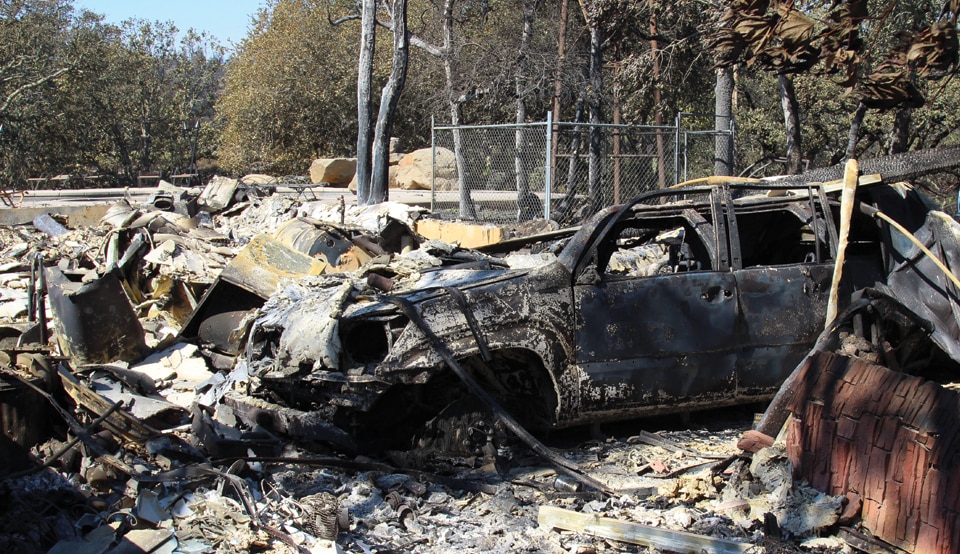
[/vc_column_text][vc_column_text]The most destructive fire in California’s modern history started near Santa Rosa at 9:40 p.m. on Sunday, October 8. In the ensuing days, the Tubbs Fire claimed forty-six lives and destroyed entire neighborhoods. Many of those who escaped the fire fled their homes with only minutes to spare. Twenty-six families that attend Redwood Covenant Church lost their homes.
A little more than five hours after the fire first started, pastors of Redwood Covenant Church opened the church’s doors to evacuees. They put the word out on social media that the church was open, and almost immediately, people began arriving. Redwood provided shelter to more than a hundred people and their animals for the first week. And in the weeks that followed, the church provided services and handed out supplies to their community.
They did not do it alone, however. On the same day they opened the church doors, Redwood started receiving help from Bayside Church, a Covenant church in nearby Sacramento. Within the first day they brought a truckload of supplies and scores of volunteers to help Redwood serve its community. Other Covenant congregations and the Pacific Southwest Conference also began contributing significantly to Redwood’s relief work.
People have stopped us on the street to say thank you.
Since the fire, Redwood and Bayside have sponsored multiple community-wide events and helped students and faculty of a local school district who lost their homes. They also are helping churches that have been damaged to rebuild. “People have stopped us on the street to say thank you,” said Dan Ferguson, Redwood’s connections pastor. And Bayside in Sacramento decided to delay a major capital campaign for nearly a year so that it can focus on helping the community.
The two congregations now plan to work with the Covenant, nonprofits, and government organizations for the next five to six years as Santa Rosa and Sonoma County rebuild. They also intend to offer large monthly events that include Serve Days and workshops, as well as help people find homes.
The churches’ long-term strategy will develop as the area’s needs evolve. Currently, what the community will look like is far from certain. Sonoma County officials have said they expect 8,000 people will never return.
Rebuilding costs have risen, and many homeowners and landlords are unable to pay for repairs beyond what is covered by their insurance. And for many of those who decide to return, rebuilding their lives as well as their homes will be far from easy.
[/vc_column_text][/vc_column][/vc_row][vc_row][vc_column][vc_separator][vc_column_text]
Thomas Fire & Mudslide: Montecito
[/vc_column_text][/vc_column][/vc_row][vc_row][vc_column][vc_column_text]
The Thomas Fire—the largest in California’s history—burned hundreds of square miles last December before firefighters halted its progress less than half a mile from Montecito Covenant Church, located in Santa Barbara County. It had traumatized many in the region who had been forced to evacuate their homes a week before Christmas due to the threat of flames and the ash that hung heavy in the air. Then, on January 9, following heavy rains, more than a million pounds of mud and boulders crashed down a nearby hillside, killing twenty-three people. A teenager who attends the youth group at Montecito Covenant was pulled from the mud after being trapped for several hours. Her mother also suffered injuries. Her father and brother were killed.
The emotional trauma continues for people throughout the area, whether or not they lost loved ones and homes, says Jon Lemmond, Montecito’s associate pastor. Their emotional and spiritual needs have been far greater than financial concerns, Lemmond says. People have been turning to local congregations for help.
“Church is an abstract concept to most people,” he explains. But when disasters of the magnitude that overwhelmed Santa Barbara and Montecito strike, then people discover the church can be a place to go. “We tell people that we’re a safe place where you can fall apart. Hope can come but it’s not going to come if you gloss over real loss.”
Not addressing the pain can lead to marital strife, depression, and substance abuse within months, says Lemmond, who came on staff during the Tea Fire of 2008, which destroyed the homes of twenty-one church families.
We tell people that we’re a safe place where you can fall apart.
The church and three other congregations have been working with the Institute for Congregational Trauma and Growth, headquartered in the area, on ways to help the community, including the elementary school next door. Two of its students died in the mudslide. “There are a number of ways we are considering to help families and individuals, but it’s important that we keep listening,” Lemmond says.
Listening is the primary approach the Covenant will continue to take as it responds to the recent disasters and others that are certain to come, says Cecilia Williams. “We want to listen, and we want to continue to be the hands and feet of Jesus as we help people in need wherever they are. We want people to know they aren’t ever forgotten and that we are here for them.”
[/vc_column_text][/vc_column][/vc_row]


